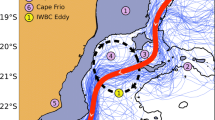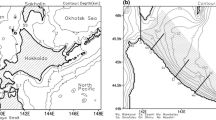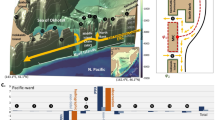Abstract
The theoretical problem of formation of boundary currents in an idealized basin subject to seasonally varying buoyancy forcing is considered in an attempt to apply it to the seasonally varying Tsushima Current. Until now, all the theories intended to explain the branching of the Tsushima Current have been for the annual mean Tsushima Current—the seasonally varying Tsushima Current has never been properly explained. A simple numerical experiment shows that eastern and western boundary currents change in time, concurrently, when local buoyancy forcing is sufficient, as it is in the Tsushima Current. However, this is not true for ineffective local buoyancy forcing. The importance of the role played by local buoyancy forcing is further supported by simple theoretical considerations. Overall, this study suggests that effective local buoyancy forcing is probably essential to the formation of seasonally varying eastern and western boundary currents of the Tsushima Current.













Similar content being viewed by others
Notes
The Editor-in-Chief recommends the usage of term “Sea of Japan” or “Japan Sea” in place of “East/Japan Sea”.
References
Bleck R, Boudra DB (1981) Initial testing of a numerical ocean circulation model using a hybrid (quasi-isopycnic) vertical coordinate. J Phys Oceanogr 11:755–770
Bleck R, Boudra DB (1986) Wind-driven spin-up in eddy-resolving ocean models formulated in isopycnic and isobaric coordinates. J Geophys Res 91:7611–7621
Cho YK, Kim K (2000) Branching mechanism of the Tsushima Current in the Korea Strait. J Phys Oceanogr 30:2788–2797
Davey MK (1983) A two-level model of a thermally forced ocean basin. J Phys Oceanogr 13:169–190
Fukudome KI, Yoon JH, Ostrovskii A, Takikawa T, Han IS (2010) Seasonal volume transport variation in the Tsushima Warm Current through the Tsushima Straits from 10 years of ADCP observations. J Oceanogr 66:539–551
Hirose N, Kim CH, Yoon JH (1996) Heat budget in the Japan Sea. J Oceanogr 55:217–235
Hogan PJ, Hulbert HE (2000) Impact of upper ocean-topographical coupling and isopycnal outcropping in Japan/East Sea models with 1/8 degree to 1/64 degree resolution. J Phys Oceanogr 30:2535–2561
Ichiye T, Takano K (1988) Mesoscale eddies in the Sea of Japan. La Mer 26:69–79
Kawabe M (1982a) Branching of the Tsushima Current in the Japan Sea. Part I: data analysis. J Oceanogr Soc Jpn 38:95–107
Kawabe M (1982b) Branching of the Tsushima Current in the Japan Sea. Part II: numerical experiment. J Oceanogr Soc Jpn 38:183–192
Kawamura H, Ito T, Hirose N, Takikawa T, Yoon JH (2009) Modeling of the branches of the Tsushima Warm Current in the Eastern Japan Sea. J Oceanogr 65:439–454
Kim YJ (2008) A study on the Japan/East Sea oceanic circulation using an ultra-high resolution model. Dissertation, Kyushu University
Kim CH, Yoon JH (1999) A numerical modeling of the upper and the intermediate layer circulation in the East Sea. J Oceanogr 55:327–345
Minato S, Kimura R (1980) Volume transport of the western boundary current penetrating into a marginal sea. J Oceanogr Soc Japan 36:185–195
Moon JH, Hirose N, Yoon JH, Pang IC (2009) Effect of the along-strait wind on the volume transport through the Tsushima/Korea Strait in September. J Oceanogr 65:17–29
Morimoto A, Yanagi T (2001) Variability of sea surface circulation in the Japan Sea. J Oceanogr 57:1–13
Naganuma K (1977) The oceanographic fluctuations in the Japan Sea. Mar Sci 9:137–141 (in Japanese, with English abstract)
Nishida Y, Kanomata I, Tanaka I, Sato S, Takahashi S, Matsubara H (2003) Seasonal and interannual variations of the volume transport through the Tsugaru Strait. Oceanogr Jpn 12:487–499 (in Japanese, with English abstract)
Ohshima KI (1994) The flow system in the Japan Sea caused by a sea level difference through shallow straits. J Geophys Res 99:9925–9940
Ou HW (2001) A model of buoyant throughflow: with application to branching of the Tsushima Current. J Phys Oceanogr 31:115–126
Sasajima Y, Nakada S, Hirose N, Yoon JH (2007) Structure of the subsurface counter current beneath the Tsushima Warm Current simulated by an ocean general circulation model. J Oceanogr 63:913–926
Seung YH, Yoon JH (1995) Robust diagnostic modeling of the Japan Sea circulation. J Oceanogr 51:421–440
Spall MA (2002) Wind- and buoyancy-forced upper ocean circulation in two-strait marginal sea with application to the Japan/East Sea. J Geophys Res 107(C1). doi:https://doi.org/10.1029/2001JC0009666
Spall MA (2003) Islands in zonal flow. J Phys Oceanogr 33:2689–2701
Yoon JH (1982a) Numerical experiment on the circulation in the Japan Sea. Part III. Mechanism of the Nearshore Branch of the Tsushima Current. J Oceanogr Soc Jpn 38:125–130
Yoon JH (1982b) Numerical experiment on the circulation in the Japan Sea. Part I. Formation of the East Korean Warm Current. J Oceanogr Soc Japan 38:43–51
Yoon JH, Kawamura H (2002) The formation and circulation of the intermediate water in the Japan Sea. J Oceanogr 58:197–211
Yoon JH, Suginohara N (1977) Behavior of warm water flowing into a cold ocean. J Oceanogr Soc Japan 33:272–282
Acknowledgments
This work was supported by a Korea Research Foundation Grant funded by the Korean Government (MOEHRD; KRF-2007-313-C00787).
Author information
Authors and Affiliations
Corresponding author
Rights and permissions
About this article
Cite this article
Seung, Y.H., Kim, K.J. Boundary currents in a meridional channel subject to seasonally varying buoyancy forcing: application to the Tsushima Current. J Oceanogr 67, 563–575 (2011). https://doi.org/10.1007/s10872-011-0057-9
Received:
Revised:
Accepted:
Published:
Issue Date:
DOI: https://doi.org/10.1007/s10872-011-0057-9




